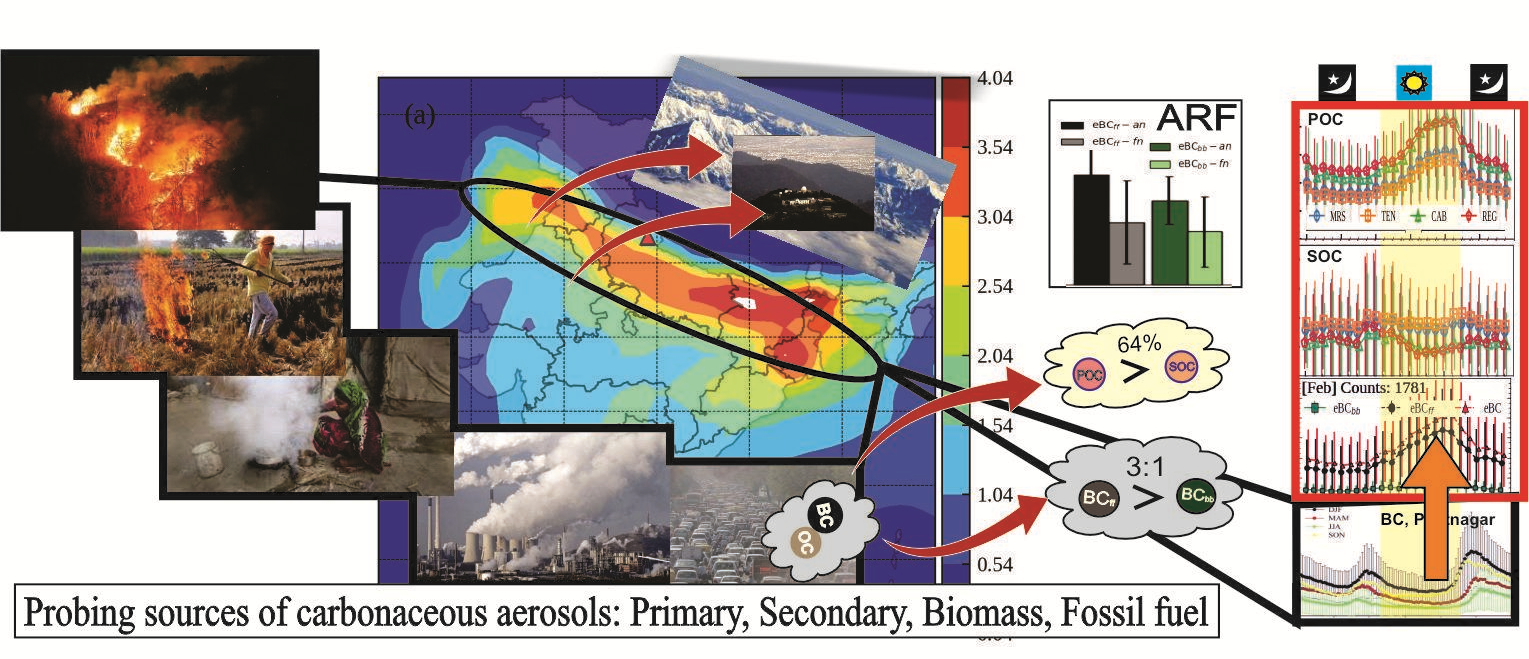A new study shows that the influence of fossil fuel combustion on air pollution in the Himalayas extends throughout the year with greater impact on warming than biomass burning, which is notable in specific months, particularly the winter months. The study could help informed policymaking and facilitate understanding the health and climatological impacts in the Himalayas.
Earlier research has hinted at the Himalayas suffering from the influx of these pollutants, transported from the neighboring Indo-Gangetic plain. However, a quantitative assessment of the origins of these carbonaceous aerosols in the region was lacking. This vital missing piece of the puzzle has curtailed informed policy decisions aimed at mitigating regional pollution.
To fill this gap, researchers from Aryabhatta Research Institute of Observational Sciences (ARIES), an autonomous institute under the Department of Science & Technology, and the University of Delhi under the aegis of DST and ISRO funded projects for the first-time conducted extensive high-resolution ground-based observations of the carbonaceous aerosols for four years over the complex and pristine terrain of the Himalayas at ARIES, Nainital.
Unraveling the mysteries of organic carbon sources in this region posed a formidable challenge, as direct methods were notably absent. So, in the research now published in an international journal: ‘Aerosols and Air Quality Research’ led by Dr. Priyanka Srivastava, along with her PhD supervisors Dr. Manish Naja and Prof. T.R. Seshadri utilized four different indirect methods to deconvolute organic carbon (OC) into its primary (directly emitted) and secondary (processed in the atmosphere) counterparts. Heterogeneity in optical absorption over different wavelengths was used for quantifying the contributions of fossil fuel combustion and biomass burning to Black Carbon.
The results revealed that fossil fuel combustion accounted for 3.5 times more BC than biomass burning on an annual basis. It was also found that a dominant fraction of organic content ranging from 56-80% came from the primary sources while secondary sources accounted for 20-44%. Importantly, the results showed that most of these higher fossil fuel combustion values and primary organic content was transported during the daytime from the lower altitude polluted sites to the cleaner air of the Himalayas.
The study also revealed the role of crop residue burning in northern India and forest fires in impacting the Himalayas during spring while local heating-purpose emissions dominated in winter. Further, their assessment of the radiative impact of aerosols showed that fossil fuel combustion has a more significant warming impact than biomass burning, which could potentially exacerbate climate change in the region.
The comprehensive investigation unveiled the sources and radiative impacts of carbonaceous aerosols, encompassing black carbon (BC) and organic carbon (OC). It also revealed that Black Corbon ranked second only to CO2 as a climate forcer, and OC, renowned for their detrimental effects on health and climate, constitute a significant portion of particulate matter (PM).
Crucially, the study emphasized that the influence of fossil fuel combustion extends throughout the year, warranting urgent attention, while the contribution from biomass burning flares in specific months. These revelations form keystones in informed policymaking, constraining the radiation budget and helping in understanding the health and climatological impacts in this region of the Himalayas.
Publication link: https://doi.org/10.4209/aaqr.220381
For more details, please email Dr. Manish Naja on manish[at]aries[dot]res[dot]in.

Fig. Graphical summary of the research paper depicting the distribution of black carbon over India along with the emission activities in the Indo-Gangetic Plain influencing the Himalayas. Rightmost panel shows the diurnal variations in fossil fuel combustion (eBCff) and biomass burning (eBCbb) fractions of BC and, secondary organic carbon (SOC) and POC obtained using four methods averaged for the four seasons during 2014–2017. Error bars represent one standard deviation from the mean. Middle panel shows the segregation of components in total BC and OC and the respective contribution of fossil fuel and biomass burning to radiative forcing during afternoon and forenoon.






























